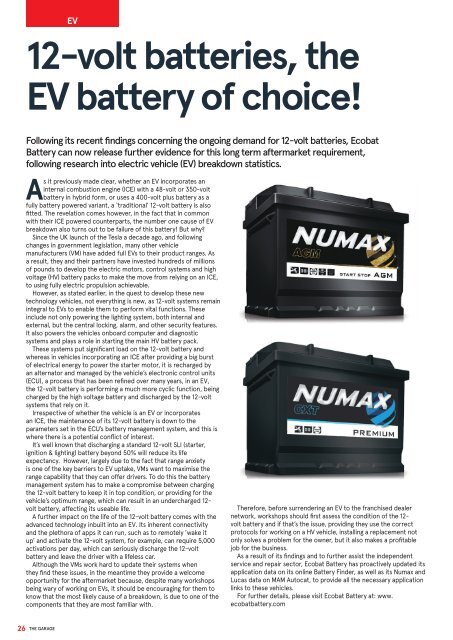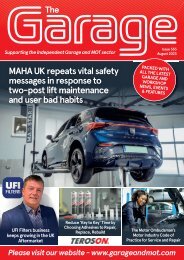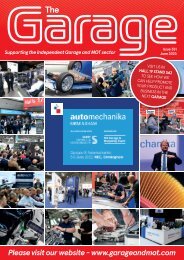The Garage 361
You also want an ePaper? Increase the reach of your titles
YUMPU automatically turns print PDFs into web optimized ePapers that Google loves.
EV<br />
12-volt batteries, the<br />
EV battery of choice!<br />
Following its recent findings concerning the ongoing demand for 12-volt batteries, Ecobat<br />
Battery can now release further evidence for this long term aftermarket requirement,<br />
following research into electric vehicle (EV) breakdown statistics.<br />
As it previously made clear, whether an EV incorporates an<br />
internal combustion engine (ICE) with a 48-volt or 350-volt<br />
battery in hybrid form, or uses a 400-volt plus battery as a<br />
fully battery powered variant, a ‘traditional’ 12-volt battery is also<br />
fitted. <strong>The</strong> revelation comes however, in the fact that in common<br />
with their ICE powered counterparts, the number one cause of EV<br />
breakdown also turns out to be failure of this battery! But why?<br />
Since the UK launch of the Tesla a decade ago, and following<br />
changes in government legislation, many other vehicle<br />
manufacturers (VM) have added full EVs to their product ranges. As<br />
a result, they and their partners have invested hundreds of millions<br />
of pounds to develop the electric motors, control systems and high<br />
voltage (HV) battery packs to make the move from relying on an ICE,<br />
to using fully electric propulsion achievable.<br />
However, as stated earlier, in the quest to develop these new<br />
technology vehicles, not everything is new, as 12-volt systems remain<br />
integral to EVs to enable them to perform vital functions. <strong>The</strong>se<br />
include not only powering the lighting system, both internal and<br />
external, but the central locking, alarm, and other security features.<br />
It also powers the vehicles onboard computer and diagnostic<br />
systems and plays a role in starting the main HV battery pack.<br />
<strong>The</strong>se systems put significant load on the 12-volt battery and<br />
whereas in vehicles incorporating an ICE after providing a big burst<br />
of electrical energy to power the starter motor, it is recharged by<br />
an alternator and managed by the vehicle’s electronic control units<br />
(ECU), a process that has been refined over many years, in an EV,<br />
the 12-volt battery is performing a much more cyclic function, being<br />
charged by the high voltage battery and discharged by the 12-volt<br />
systems that rely on it.<br />
Irrespective of whether the vehicle is an EV or incorporates<br />
an ICE, the maintenance of its 12-volt battery is down to the<br />
parameters set in the ECU’s battery management system, and this is<br />
where there is a potential conflict of interest.<br />
It’s well known that discharging a standard 12-volt SLI (starter,<br />
ignition & lighting) battery beyond 50% will reduce its life<br />
expectancy. However, largely due to the fact that range anxiety<br />
is one of the key barriers to EV uptake, VMs want to maximise the<br />
range capability that they can offer drivers. To do this the battery<br />
management system has to make a compromise between charging<br />
the 12-volt battery to keep it in top condition, or providing for the<br />
vehicle’s optimum range, which can result in an undercharged 12-<br />
volt battery, affecting its useable life.<br />
A further impact on the life of the 12-volt battery comes with the<br />
advanced technology inbuilt into an EV. Its inherent connectivity<br />
and the plethora of apps it can run, such as to remotely ’wake it<br />
up’ and activate the 12-volt system, for example, can require 5,000<br />
activations per day, which can seriously discharge the 12-volt<br />
battery and leave the driver with a lifeless car.<br />
Although the VMs work hard to update their systems when<br />
they find these issues, in the meantime they provide a welcome<br />
opportunity for the aftermarket because, despite many workshops<br />
being wary of working on EVs, it should be encouraging for them to<br />
know that the most likely cause of a breakdown, is due to one of the<br />
components that they are most familiar with.<br />
<strong>The</strong>refore, before surrendering an EV to the franchised dealer<br />
network, workshops should first assess the condition of the 12-<br />
volt battery and if that’s the issue, providing they use the correct<br />
protocols for working on a HV vehicle, installing a replacement not<br />
only solves a problem for the owner, but it also makes a profitable<br />
job for the business.<br />
As a result of its findings and to further assist the independent<br />
service and repair sector, Ecobat Battery has proactively updated its<br />
application data on its online Battery Finder, as well as its Numax and<br />
Lucas data on MAM Autocat, to provide all the necessary application<br />
links to these vehicles.<br />
For further details, please visit Ecobat Battery at: www.<br />
ecobatbattery.com<br />
5<br />
26 THE GARAGE<br />
21 Feature EV.indd 6 27/03/2024 13:52

















